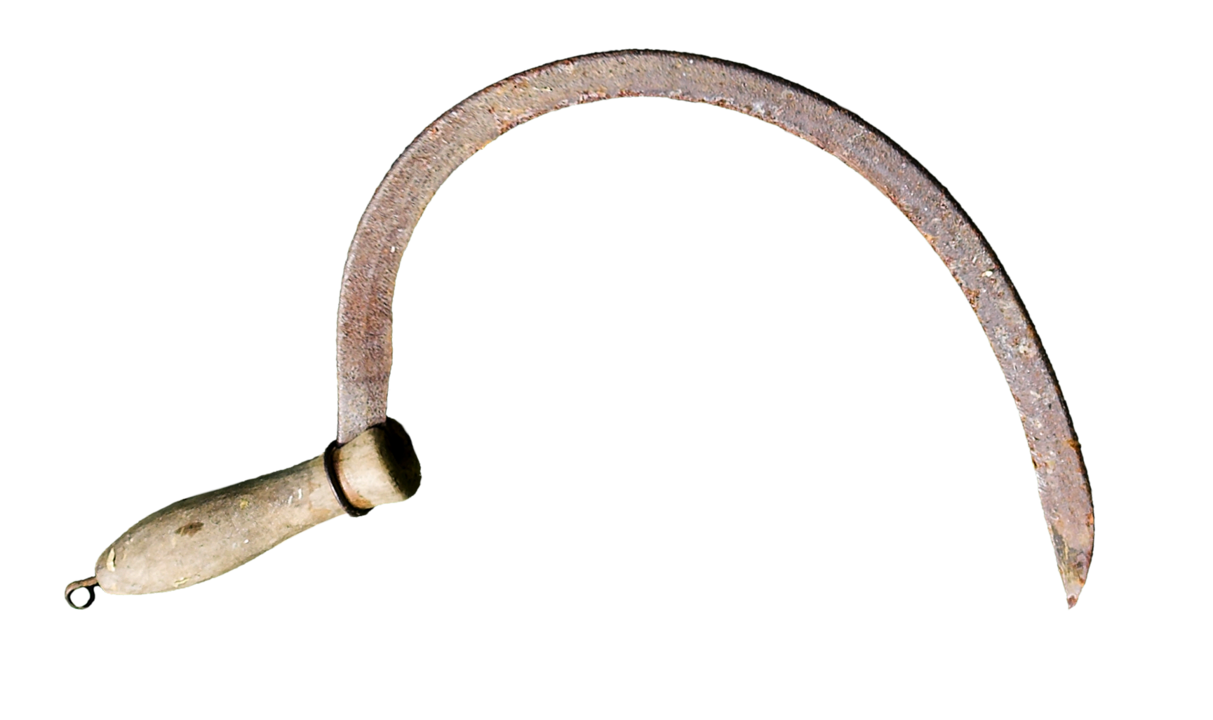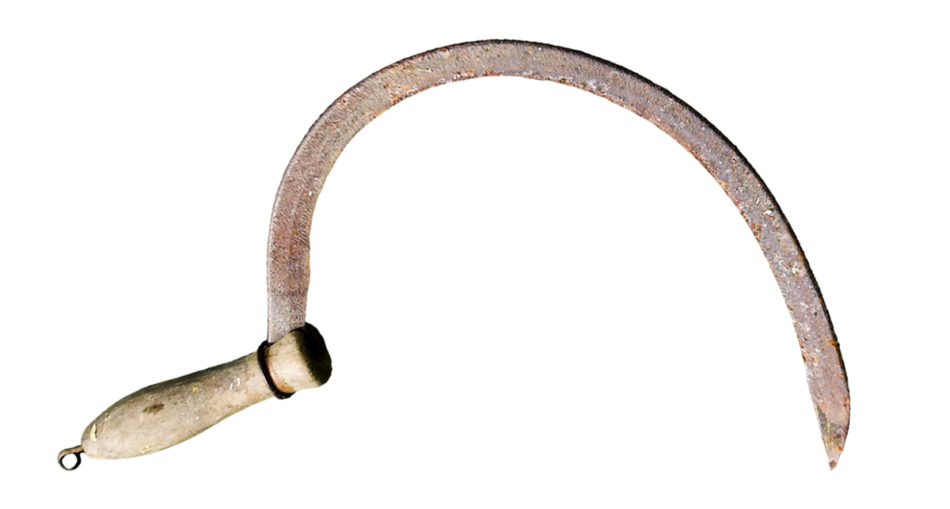The Sickle is an agricultural tool primarily used for cutting and reaping. There are numerous variations of the tool around the world in places like Africa, Asia, and North America. In Guyana and other parts of South America, the Sickle is used to reap rice and to cut grass. The agricultural implement is also known as the grass knife in Guyana but elsewhere as a reaping hook, grass hook, swap hook, rip-hook, slash-hook, brushing hook, bagging hook, aashi (Nepal) celurit or clurit (Madura). Its short handle makes its perfect for reaping grainlike crops while its curved blade gathers to crop for a clean, neat cut. Because it is a simple and effective tool, the Sickle is still used today around the world.

A Sickle – Photo By Sickle_hanging_from_a_rusty_nail_at_Ardeshir’s_farm.jpg: Christopher Walker from Bielsko-Biala, Polandderivative work: Amada44 talk to me – Sickle_hanging_from_a_rusty_nail_at_Ardeshir’s_farm.jpg, CC BY 2.0, https://commons.wikimedia.org/w/index.php?curid=15353423
Origin of The Sickle
There is not one specific, defined origin of the Sickle but the tool has been prevalent since the Stone Age, evolving as time passed. There are several variations made from or iron and steel but the earliest form was made of bone and stone. The knob-sickle is one such example which has a knob on the base of the tool hence the name.
Description of The Sickle
The Sickle is an agricultural tool used with one hand. It has a curved blade, attached to a short, wood handle which provides good grip. While the outer side of the blade is not shaped, the inner side of the blade is sharpened so stems can be collected in the curve and sliced simultaneously. Sickles made specifically to cut grass are turned downwards from the handle, allowing for the blade to be used closest to ground as possible. On the other hand, the Sickle used to reap grains are different and often has serrated edges.
Traditional Uses of The Sickle
- The Madurese people from the island of Madura use the Sickle (celurit or clurit) as both a domestic tool and weapon.
- Publius Cornelius Tacitus also known as Gaius Cornelius Tacitus, was a Roman public official and historian who reported that the Druids used golden sickles in their rituals.
Interesting Tip
- Druids are members of an order of priests in Britain and Gaul, typically prevalent as prophets and sorcerers in Irish and Welsh legends.
Uses of The Sickle
- In Guyana, the Sickle or the grass knife is used in the traditional way of reaping of rice, usually on a small scale.
- The Sickle is also used as a gardening tool to cut grass.
- People used to Sickle to cut grass to prepare bedding and matting.
- In Nepali villages, the aashi or Sickle is used in the preparation of vegetables for cooking where it is used to cut vegetables. The handle of the asshi is pressed upon with your toes while the vegetables are held and cut by moving the tool back and forth.
- A large number of Sickles were used as weapons including the makaraka of the Zande people in North Central Africa, the Japanese kama and kusarigama, Chinese chicken Sickles.
- The tool is also very popular in martial arts of countries like Indonesia, Malaysia and the Philippines.
- When the bean hook or pea hook was unavailable the Sickle was used to cut field beans to sue as bedding and fodder for livestock.
5 Facts About The Sickle
- The Sickle in Mesopotamia, Western Asia can be traced back to periods predating the Neolithic Era.
- The Sickle drastically influenced the Agricultural Revolution, enabling the transition to farming and crop-based lifestyle. Bronze Age Sickles are separated in classes by the way their handles were attached.
- The aashi or Sickle is put in a sheath or khurpeto for safety.
- Serrated stones were attached to bone or wood during the Stone Age was among the oldest of Sickles.
- China produces the largest number of sickle while Italy disbelieved to produce the tool in the best quality.
About The Sickle
Locally known as the grass knife, the Sickle is a popular agricultural tool in the country. Its wooden handle and curved shape make it very suitable for cutting and reaping. While it may not be used to reap or to ‘cut’ rice on a large scale, many Guyanese still use it for domestic purposes.
Article References
- https://en.wikipedia.org/wiki/Sickle
- https://guyaneseonline.files.wordpress.com/2012/07/from-the-chamber-pot-to-the-computer-in-guyana.pdf
- https://en.wikipedia.org/wiki/Sickle#:~:text=A%20sickle%2C%20bagging%20hook%20or,cut%20or%20dried%20as%20hay.
- https://www.britannica.com/topic/sickle-hand-tool
Discover more from Things Guyana
Subscribe to get the latest posts sent to your email.








1 Comment
Pingback: Best 23 Sickle Agricultural Tool - Au Idol